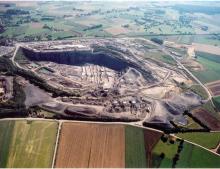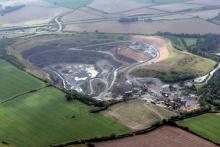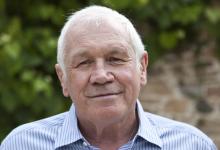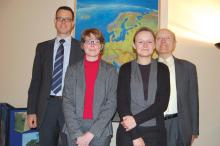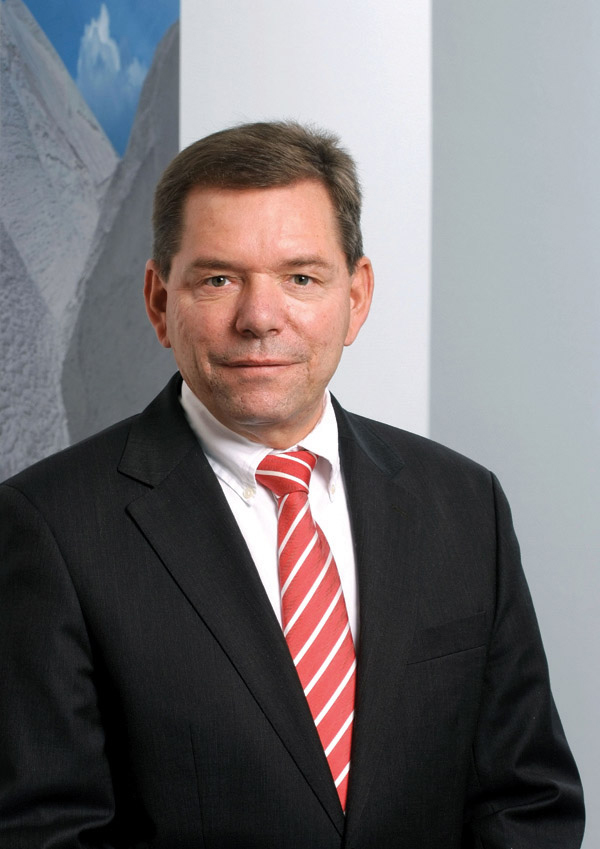
Following Heidelberg's record breaking acquisition of Hanson last year, the company has set up a new Competence Centre for Materials. Claire Symes interviews the man charged with leading the business in Europe, Gerhard Mühlbeyer
The €11.7billion price tag paid by Heidelberg Cement for
However, integration of the new business has also signalled a step change in how Heidelberg approaches the aggregates market. Last year the company took the step to develop a Competence Centre for Materials (CCM) - covering aggregates, ready mixed concrete and asphalt - and separate this development from its cement business. The man tasked with driving forward the company's aggregates business is CCM director Gerhard Mühlbeyer.
"The role of the CCM is to provide global benchmarking and seek out areas of improvement as well as check and prioritise capital expenditure," he explained. "The CCM's offices in Belgium, Germany, the UK, North America and Australia cover all of Heidelberg's operations in the field of aggregates, ready mixed concrete and asphalt. The CCM was developed in recognition of the different approach to investment needed in these sectors compared to the cement business." In addition to seeking out new investment opportunities for Heidelberg, Mühlbeyer's team also carry out project management for schemes in Europe by providing in-house engineering with a view to creating operational excellence. Additionally the department also provide property management and geological skills to its 288 quarries located in Europe.
Understanding
Mühlbeyer is clearly passionate about the aggregates sector. "The thing that really motivates me about working in this sector is that when you look around the visible world, what you see can always be traced back to aggregates," he said. "Most people don't think about where aggregates come from, they just take it as given that they are there. To dig out sand and gravel or to black out rock creates a huge value. When it is in the ground, the value is zero, but once you extract process it, you are creating great value." Talking about his new role, Mühlbeyer said that he spends around 50% of his time out in the company's quarries, because he thinks it is vital understanding the differences that exist within individual markets and production sites. Nonetheless, aggregates were not what originally drove Mühlbeyer to join Heidelberg in 1982 - it was more the approach to business that attracted him.
He joined after gaining a degree in economics from Mannheim University and he started work in Heidelberg's cement sales. "With my career ahead of me, Heidelberg seemed like a good opportunity as there is a real culture of developing entrepreneurial skills and being able to use them on a daily basis," he said. "That spirit still exists today." When Mühlbeyer first joined Heidelberg, its annual turnover was around €420million. "In the early 1980s, Heidelberg was a southern German company with cement and ready mixed concrete operations and a US arm in the form of Lehigh, which was acquired in 1977," he explained.
After spending two years in cement sales, Mühlbeyer then moved into ready mixed concrete in Germany. "It was an excellent time to be working in ready mixed concrete as the growth was fast paced - at the time there was a high speed rail link being built between Würzburg and Hanover so there were lost of new bridges and tunnels being built," he said. "I remember one site in the Bear Valley where two tunnels were being built and we supplied 400,000m3 of concrete to the site over 18 months." His first experience of the quarrying sector came when Heidelberg bought a sand and gravel company on the banks of the Rhine and Mühlbeyer was tasked with developing and managing the enterprise. "My role involved everything from production and sales through to applying for permits," he said. "I started from scratch with the aggregates sector and learnt about it by doing it first hand which has given me a good grounding in the industry. Everything about aggregates is based on experience." After managing the company near the Rhine, Mühlbeyer then moved into developing the business in Eastern Europe before spending four years working on the company's US-based ready mixed concrete and aggregates operations.
Mühlbeyer believes that his experience over the last 25 years is standing him in good stead for his current role. "I have worked in aggregates and ready mixed concrete on both sides of the business," he said. "On the ready mixed site, I understand the aggregate producers' perspective, while on the aggregates side, I understand the customers' perspective."
Verticalisation
Heidelberg's expansion beyond its core business of cement started in the 1950s with the move into the ready mixed concrete sector. "By adding verticalisation to the business, Heidelberg aimed to add value by being involved in the downstream markets," said Mühlbeyer . "Adding aggregates to the business is a natural step forward in the strategy as it adds the necessary raw materials for the downstream businesses." Heidelberg's quarrying portfolio has been gradually expanded by acquisition and organic growth and the company now has 288 quarries in Europe with operations in the UK, Northern Europe, Eastern Europe, Benelux, Germany, Spain and Israel. In the first nine months, the combined quarrying operations had an output of 95million tonnes and are expected to record a total of 125million tonnes for the full year. Turnover for aggregates, ready mixed concrete and asphalt operations reached €2.7billion in the first nine months of this year.
The figures for Heidelberg's quarrying activities were significantly boosted by the acquisition of Hanson last year but the takeover was the latest in a line of key buyouts over the last 24 years. "Heidelberg was a late starter in the aggregates sector and it was the early 1990s reunification boom in Germany that firmly moved Heidelberg into the aggregates market," said Mühlbeyer. "The next step was in 1994 with the takeover of Belgium-based CBR with aggregates operations in Belgium, the US and Canada. Other key acquisitions helped further develop the business, including the acquisition of Scancem with its substantial aggregates operations in Northern Europe." According to Mühlbeyer, the focus at Heidelberg is always on the strategic location of the business and has targeted both its organic and acquisitive growth with this in mind. It was the strategic fit that led to the takeover of Hanson - Heidelberg already had cement operations in the UK in the form of Castle Cement but no aggregates operations. In the US, they had a strong cement business on the East Coast and in California but no aggregates and only some ready mixed concrete. It also provided Heidelberg with access to new markets such as Australia and Malaysia.
"Hanson was a profitable business with excellent prospects," said Mühlbeyer . "The company also had a lot of synergies with our existing operations and gave us a route into new markets that offered growth for the future." Mühlbeyer believes that one of Heidelberg's key achievements is always being one of the leaders when it comes to market share in any country is operates in. "We aim to be within the top five as it doesn't make sense to us to have just one or two quarries in a market and be a minor player," he said.
According to Mühlbeyer, this culture of achieving critical mass and taking a long term view can be traced back to Heidelberg's roots as a cement company. "On the cement side of the business, we would never build a plant at a site where there are just 10 years of reserves but look for opportunities that offer 50 or 100 years of reserves. It is the same when it comes to aggregates," he said. "We have an excellent position when it comes to aggregates reserves and this gives us the confidence to invest." Looking at the current conditions in the European market, Mühlbeyer said that there is a decline in demand in both the UK and Spain but he is optimistic about a return to growth. "We have been through difficult periods before but have always made the best of them thanks to our strategic planning and strong cost focus even in boom periods," he said. "The market will pick up but by having a wide geographical spread, the risk from downturns is reduced." By example, Mühlbeyer points to the recession which Germany experienced between 2001 and 2005 and said that during this period the US was strong. This time around he believes it will be infrastructure investment in Eastern Europe funded by EU grants and loans which will drive continued growth.Additional benefits
In addition to being able to take a longer term view of the aggregates markets, Mühlbeyer also believes that Heidelberg's acquisitive nature also has benefits for health and safety, as well as the environment. "We apply the same health and safety guidelines right across the group and build a culture of caring for our people so that they arrive and leave work in good shape," he said.
The pan-European nature of Heidelberg's business is also allowing it to transfer best practise for nature conservation and quarry restoration from country to country. "In Germany the sand martin is an endangered species and needs freshly excavated sand backs to burrow into to build its nests," said Mühlbeyer. "All of our German sites have a policy of leaving sand banks during the nesting period and working in other areas of the site. The programme has been so successful that in one quarry there were 800 pairs of birds this year. We are now transferring the policy to sites in Poland and the Czech Republic.
"Quarrying has a real opportunity to improve the biodiversity through careful management and restoration. Transferring knowledge gained in different parts of the business is enabling us to do this more effectively."
"No one can accurately forecast when the declines in the market will start to turnaround but the key will be infrastructure investment," he said. "There will be a time lag - it will not help the market in two month's time but it could help to stabilise the market, maybe in the second half of 2009. President-elect Obama's plans for US infrastructure investment will also boost confidence because although the US was the first economy to go down, it is likely to be the first to recover and the quicker it does, the faster we will see the positive effects in Europe." Mühlbeyer said that Heidelberg is applying the same strategy to investment as it does to acquisitions by taking a long-term view of the markets and achieving operational excellence.
"We are continually reviewing capital expenditure projects but a downturn does not necessarily mean that we will cancel investment if we can see there is room for growth when demand returns," he said.
According to Mühlbeyer, this approach has benefitted the business in the past and, as an example, outlines investment in the Czech Republic where the company knew road development was planned so investment in the quarry next to the route was planned ahead of the construction. "The start date for the road was delayed but the investment took the quarry from a capacity of 400,000tonnes per year to 1.5million tonnes and when the road project got the go ahead, we were ready to supply the materials needed," he said
Much of the focus on quarry development for Heidelberg is currently on Eastern Europe and Russia. "We are working on development of two quarries in Ukraine and one on Kazakhstan and a greenfield quarry in Poland," said Mühlbeyer. "The market will pick up elsewhere and we are also working on schemes for when it does."
Such projects include work on Heidelberg's new greenfield quarry at Tellier des Prés in Belgium, which it took 16 years to gain approval for. "Aggregates are a local product, so having an efficient, strategically placed quarry will always make money. There may be times when demand is lower but it will always be profitable," said Mühlbeyer.

